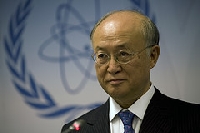Amano and Jalili agree to agree
28 May 2012
The top representatives of the International Atomic Energy Agency (IAEA) and Iran's Supreme National Security Council have decided to agree on a structured approach to clarifying possible military dimensions related to Iran's nuclear program, which should lead to inspections of the Parchin site.
 |
| A serious Yukiya Amano briefs the world's press on the Iranian situation in February (Image: IAEA Imagebank) |
The IAEA has been working with Iran to resolve outstanding issues related to Iran's nuclear program, which Iran maintains is purely peaceful in its intentions. Iran has been under sanctions from the UN Security Council since 2006 for its refusal to give up its uranium enrichment activities, although the IAEA continues to implement nuclear non-proliferation safeguards at the country's declared facilities and other locations where nuclear material is used. However, an ongoing problem for the IAEA has been Iran's continued refusal to allow inspectors to visit a military site at Parchin.
The IAEA is keen to verify suggestions that the site may have been used for development work related to nuclear weapons in the early 2000s. Iran has previously said that it would not permit such an inspection without an agreement on a so-called structured approach on clarification. Talks in January and February to try to agree a structured approach failed, but recent negotiations between the IAEA and Iran have made progress to such an extent that IAEA director general Yukiya Amano decided it would be suitable for him to visit Tehran to take the talks further. Accordingly, Amano met with Saeed Jalili, secretary of the Supreme National Security Council of Iran, as well as the head of the Atomic Energy Organisation of Iran (AEOI) Ferreydoun Abbasi and Iranian foreign minister Ali Akbar Salehi in Tehran on 21 May.
"During the meeting with Mr Jalili, it was decided to agree on a structured approach," the IAEA notes in its latest regular report on Iran's safeguards implementation. Although some differences remained, "Mr Jalili made it clear that these were not obstacles to reaching agreement."
Enrichment ongoing
In the same report the IAEA notes that Iran continues with uranium enrichment activities in its declared facilities, in contravention of IAEA and UN Security Council resolutions. Those facilities are, however, under IAEA safeguards and the agency continues to verify that no declared nuclear material at those facilities has been diverted. However, without Iran's full cooperation and implementation of the Additional Protocol to the Nuclear Non-proliferation Treaty (NPT), the agency warns that it cannot provide "credible assurance" that Iran does not have undeclared nuclear materials or activities or conclude that all of Iran's nuclear material is "in peaceful activities."
Bushehr 2?
Iran plans to begin work on a second nuclear power plant at Bushehr.
Iranian news media including official government news agency IRNA carried reports citing AEOI head Ferreydoun Abbasi as saying that work would begin on a new 1000 MWe unit between March 2013 to March 2014.
The plant would be built by foreign contractors, according to Abbasi.
Iran has two declared enrichment plants at Natanz (the Fuel Enrichment Plant, or FEP, and the Pilot Fuel Enrichment Plant, PFEP), plus another at Fordow (Fordow Fuel Enrichment Plant, FFEP). Based on Iranian figures, the IAEA reports that up to 1326 kg of 5%-enriched uranium hexafluoride (UF6) was produced at FEP between 17 October 2011 and 11 May 2012, bringing the plant's total output since it started up in 2007 to 6197 kg of 5%-enriched UF6. From 14 September 2011 to 18 May 2012, a total of 269.5 kg of UF6 enriched at FEP was fed into PFEP's two interconnected enrichment cascades, producing approximately 36.4 kg of 20%-enriched UF6. This would bring the total production of 20%-enriched UF6, which Iran maintains is for use in research reactor fuel, to 110.1 kg since production began at PFEP in 2010.
As for Fordow, the IAEA noted that as of 9 May all 174 IR-1 centrifuges had been installed in each of the fifth and sixth cascades of Unit 2, with 20 installed in a seventh cascade. Although the IAEA has asked for information on the purposes for which the fifth and sixth cascades are to be used, this has yet to be forthcoming.
Uranium feeding started into the second set of interconnected cascades at FEP unit 2 in January, and the analysis of environmental samples collected in February revealed the presence of particles with enrichment levels up to 27%, in excess of the levels stated in the information on the plant's design. According to Iran, the production of "above target value" particles may occur for reasons beyond the operator's control. The IAEA says it is still assessing Iran's explanation and has requested further details as well as analysing more recent environmental samples from the same location.
Researched and written
by World Nuclear News